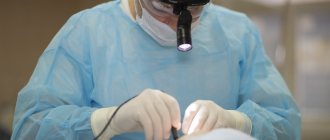In the literature you can find a description of more than 400 methods of surgical treatment of hallux valgus. In the past, podiatrists combated hallux valgus by surgically removing the articular heads, which resulted in severe impairment of foot function. Therefore, today doctors prefer to perform less traumatic operations.
X-ray.
What is hallux valgus? Initially, Hallux Valgus causes only the big toe to become bent. As a result, a person increases the load on the heads of the 2-4 metatarsal bones, which leads to hammertoe deformity of the II-V fingers. Timely surgical treatment helps to avoid this unpleasant phenomenon.
Types of foot surgeries
Operations performed for hallux valgus deformity can be divided into minimally invasive and reconstructive. The former are less traumatic, but are effective only for exostoses and initial deformation. Minimally invasive surgical interventions are performed through two or three punctures measuring 3-4 mm.
Scar after intervention.
Reconstructive interventions help to cope with severe hallux valgus deformity, accompanied by changes in the position of the bones of the foot. Such operations are more invasive and involve more trauma. They are performed through a 2-4 cm long incision on the medial surface of the foot. During surgery, the doctor restores the normal position of the metatarsal bones and fixes the first metatarsocuneiform joint in the correct position.
Table 1. Types of operations.
| Features of the event | Indications | |
| On soft tissues | During the operation, the doctor works only with the muscles, tendons and joint capsule. | Hallux Valgus I degree without deformation of the metatarsal head. |
| On the bones | The essence of such surgical interventions is to file the bones and/or perform an osteotomy. | Hallux valgus deformity II-III degree. |
| Combined | They involve simultaneous removal of bone growths and plastic surgery of ligaments. | Severe Hallux Valgus with dysfunction of the foot. |
Minimally invasive intervention.
During minimally invasive operations, the surgeon uses micro-instruments that allow complex manipulations of the ligaments and joint capsule. If necessary, he files the bones using micro-mills, which vaguely resemble dental instruments.
Name of surgical techniques
In the initial stages of the disease, doctors try to perform minimally invasive operations. After them, the patient recovers quickly and returns to his normal lifestyle within 3-4 weeks. With advanced hallux valgus deformity, the need for more complex surgical interventions arises.
Let's see which of them are most often used in modern orthopedics.
Operation McBride
The most popular among all surgical interventions on the soft tissues of the foot. Its essence is to move the tendon m. adductor halluces on the head of the first metatarsal bone. This allows you to bring the metatarsal bones closer together and restore the normal muscle-tendon balance of the foot.
McBride.
Unfortunately, the abductor pollicis muscle is unable to withstand constant stress. This is why the relapse rate after McBride surgery is quite high. If a person does not eliminate the effect of provoking factors, he will soon develop Hallux Valgus again. Wearing orthopedic shoes, avoiding heels and heavy physical work helps to avoid this.
In case of pronounced deformities, the McBride operation is supplemented with SCARF osteotomy of the first metatarsal bone.
SERI
Refers to minimally invasive operations. During surgery, patients undergo a transverse osteotomy through a 1 cm long skin incision. After this, the distal bone fragment is shifted in the lateral direction and fixed using a special wire.
SERI.
CHEVRON
During the operation, the surgeon performs a V-shaped osteotomy
. He saws the first metatarsal bone in the area of the head, and connects the bone fragments using special titanium screws. Since the fixation is very strong, the patient does not need plaster immobilization in the postoperative period.
CHEVRON.
Note that Chevron osteotomy is effective only for minor deformities of the first toe. Nowadays, it is used less and less in orthopedics. Instead, most doctors perform a Scarf osteotomy.
SCARF
The Scarf Z-shaped osteotomy is the gold standard for the treatment of hallux valgus. It allows you to set the head of the metatarsal bone at the desired angle. During surgery, doctors also remove deformation of the joint capsule and change the direction of some tendons.
SCARF.
When Scarf surgery is not enough, surgeons perform a proximal wedge osteotomy or arthrodesis.
Important! In most patients with hallux valgus, doctors detect callus (exostosis). The growth is localized on the medial surface of the head of the first metatarsal bone. As a rule, it is removed during all operations, including minimally invasive ones.
Do not confuse cutting down a bone spur with an osteotomy. These are two completely different manipulations. The goal of the first is to remove a cosmetic defect, the second is to restore the normal functional state of the foot. Remember that callus removal (Schede procedure) will not cure you of Hallux Valgus.
Exercises after bone removal
It is advisable to carry out a set of gymnastic exercises after 3 weeks, but it is worth remembering that this must be agreed with a specialist.
Training should be systematic; if you do it occasionally, it will not have the desired effect. The purpose of physical therapy is to prevent adhesions and accelerate the rehabilitation process. In addition, with regular exercise, blood circulation will improve and tone will appear in the muscles.
Starting from the 3rd week , you can move on to intensive types of exercise, but it is best to keep the pace moderate.
Exercises from week 3
- take the thumb of the limb by the base and slowly pull it towards you until a feeling of discomfort arises (some kind of resistance should appear, then the exercise is performed correctly);
- It is necessary to hold this position for 10 seconds, then smoothly release, the number of approaches is 3 times;
- take the big toe by the base and gradually pull it away from you towards the lower surface;
- It costs 10 seconds to hold in this position, only 3 repetitions are enough.
The first week of exercises can be performed 1-2 times a day, but starting from week 2 , the number should be 3-4.
Exercises from week 5
In the 5th and 6th weeks, the same exercises are performed, but the number of approaches increases, and is already 6 times a day. In addition, the intensity of their implementation also increases. In addition to the already familiar gymnastic exercises, you can add the following:
- take a sitting position and straighten your lower limbs;
- alternately stretch one and the other foot back and forth, the duration of the exercise is about 3 minutes;
- spread a small cloth on the floor, preferably a small towel or sheet;
- then place the leg from which the bone was removed on it and try to collect the material, while pulling towards yourself.
Already from the seventh week you can begin activities in which the limb is loaded with body weight.
Exercises from week 7
- take a standing position, your heels must be raised, but your toes should not leave the floor, you need to perform the exercise for about 10 seconds and return to the starting position (if doing the exercises causes pain, it is better to reduce the time to 3-5 seconds);
- walking on the street or training on a treadmill (performed similarly to the previous one, only when performing it, the step should be wide, which will help increase the range of motion in the soft tissues of the limb joint);
- scatter small objects on the floor and collect them with the operated foot;
- roll a tennis ball along the floor with your fingers.
When performing a gymnastic complex, you must ensure that all movements are correct and also pay attention to your well-being.
When performing recreational activities, there should be no discomfort or pain. If you feel tired, you need to take a break and return to therapy when the body recovers.
Additional exercises
- Fix the limb with one hand and extend the operated finger with the other;
- pull first forward and then back, the duration of the execution is about 10 seconds, and keep the foot straight;
- rest against the wall, and take the limb slightly back, press it firmly to the floor surface, while the angle of the leg should be straight (the exercise is performed for 15 seconds).
The most important thing is that the patient, during rehabilitation after surgery, needs to perform a therapeutic physical exercise complex every day. Only in this case can good results be achieved and the recovery process accelerated.
Arthrodesis for hallux valgus deformity
Arthrodesis is the complete immobilization of the metatarsal-wedge joint by connecting the bones that form it. The operation is performed on persons with transverse-spread deformity and Hallux Valgus with hypermobility of the first metatarsocuneiform joint.
Test to detect pathological mobility:
- hold the II-V metatarsal bones with the fingers of one hand;
- with the other hand, take the first metatarsal bone and try to move it in the dorsal-plantar direction;
- look how much you managed to move it;
- displacement of the bone by more than one sagittal dimension of the thumb indicates the presence of hypermobility.
Arthrodesis is the most traumatic operation, involving complete removal of the metatarsocuneiform joint. It is done only as a last resort when other methods are ineffective.
Surgery for hammertoe deformity
As is known, in the later stages of Hallux Valgus it is combined with hammertoe deformity of the II-V fingers. It looks unattractive and negatively affects the functions of the foot. To correct it, a number of surgical interventions are used.
These include:
- Closed redressing.
The essence of the technique is to forcibly correct the defect non-surgically. Unfortunately, redressal has little effect, and relapses often occur after it. - Tenotomy or tendon transposition.
Operations are performed on the ligaments of the foot. Their skillful intersection or movement allows you to correct hammertoe deformity. - Bone resection.
During surgery, doctors excise the base of the middle or head of the main phalanx. This allows you to get rid of excess bone mass and eliminate deformation. - Weil or Wilson osteotomies.
They resemble Scarf and Chevron operations, but are performed on the II-V metatarsal bones. Surgeons cut them open and then fix the bone fragments with titanium screws.
Osteotomy is most effective in treating hammertoe deformity. This is what is performed in the most severe and advanced cases.
How to recognize the disease?
The following changes indicate the development of a bone in the leg:
- the thumb deviates outward, while forming a “ball” at its base;
- there is constant aching pain in the area of deformity;
- fast fatiguability;
- difficulties with choosing shoes.
In the absence of treatment and progression of the pathology, a hammer-shaped shape of the remaining toes is observed. The appearance of the slightest signs of disease should be a reason to contact an orthopedist.
Recovery period
Patients are allowed to get out of bed the very next day after surgery. At first they are allowed to walk only in Baruk's shoes.
Baruk's shoes.
In the first days after surgery, patients are under the supervision of the attending physician. They are discharged from the hospital within 2-3 days. If a person was given non-absorbable sutures during the operation, they are removed after 10-14 days.
Regarding footwear, patients are required to wear orthotics for at least 3 months. You can wear heels only six months after surgery. However, their height should not exceed 6 cm.
Conservative approaches for treating “bumps”
- Laying various fabrics (for example, felt) to reduce pressure on the bunion area.
- Physiotherapy treatment: laser, ultrasound are carried out to relieve the inflammatory and degenerative manifestations of the disease.
- Any calluses or abrasions on the skin that are also a source of pain should be treated.
- In order to prevent deviation of the first toe, it is recommended to wear physiological, properly selected shoes.
- If the deformity of the toe is severe, it is necessary that the shoes stretch well, especially the toe - this will relieve pressure on the bone.
- It is recommended to wear individual orthopedic insoles, which help to correctly distribute the loads on the foot when walking and running.
- Range of motion should be improved through exercise therapy and foot massage.
Cost of foot surgery
The cost of surgical treatment depends on the degree of deformity, the type and complexity of the operation, the level of the medical institution and the qualifications of the specialists working there. Removal of exostosis in Moscow costs from 40,000 to 50,000 rubles. Prices for reconstructive operations start at 70,000 rubles. Please note that the price does not include preoperative examination, specialist consultations, consumables and rehabilitation.
If you want to have surgery abroad, pay attention to the Czech Republic. Treatment there will cost you in euros including rehabilitation. In Germany and Israel, the same operation will cost much more.











